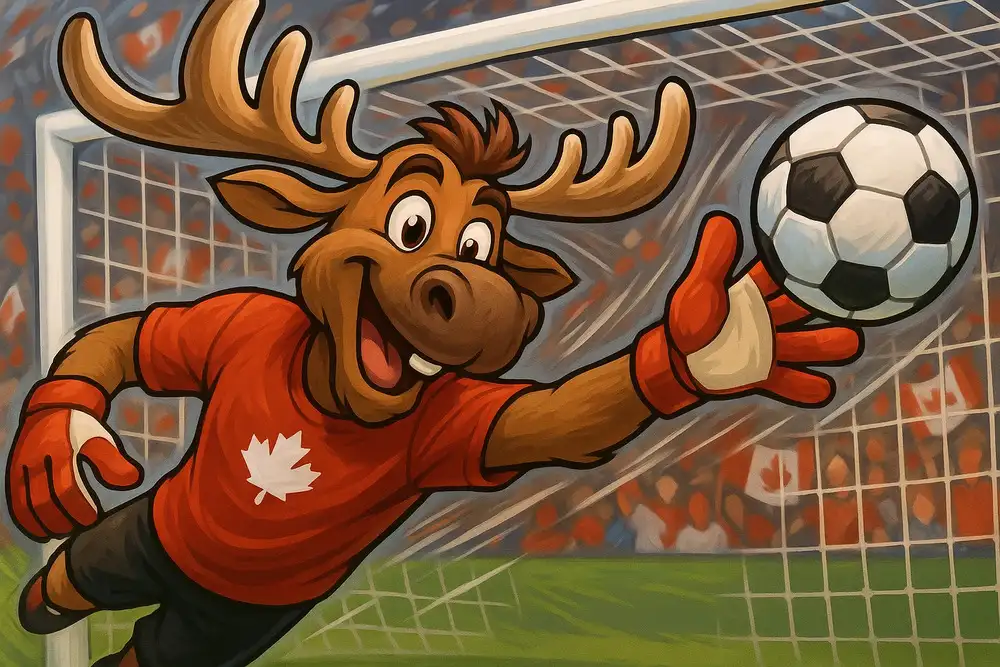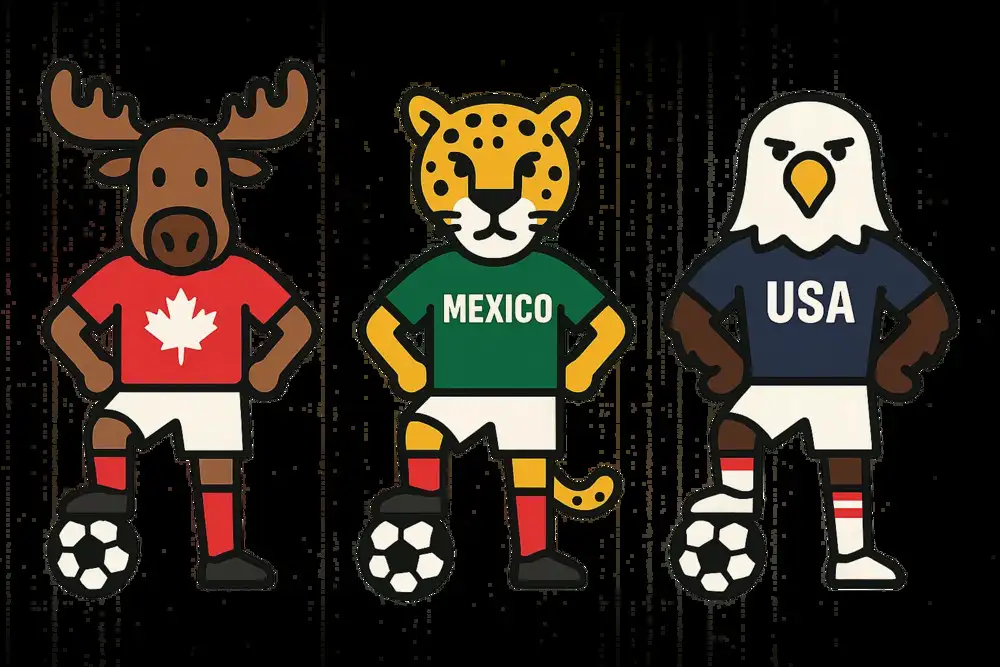If you typed “mascotas Mundial 2026” into a search engine, you’re probably asking one simple question:
Who are the official mascots of the FIFA World Cup 2026 – and what do they mean?
For the first time, the men’s FIFA World Cup will be hosted by three countries at once – Canada, Mexico and the United States – and that historic moment comes with a brand-new trio of mascots:
Maple the Moose for Canada
Zayu the Jaguar for Mexico
Clutch the Bald Eagle for the United States 国际足联+1
These characters were officially unveiled in late 2025 and immediately became the answer to millions of searches for “mascotas Mundial 2026”. They aren’t just cute animals; each one has a backstory, a playing position and a set of values that represent the spirit of their home nation and of the tournament as a whole. ESPN.com+1
In this guide, we’ll walk through everything fans, parents, kids and content creators want to know:
Who exactly are Maple, Zayu and Clutch?
What do they represent for Canada, Mexico and the U.S.?
Why did FIFA choose three mascots instead of one?
How do they fit into the history of World Cup mascots?
Where will fans see them – in stadiums, video games, social media and merchandise?
By the end, your question about “mascotas Mundial 2026” won’t just be answered – you’ll have plenty of ideas for content, fan art and Sora visuals too.

Let’s start with the basics. The official mascots for the FIFA World Cup 2026 are a trio of anthropomorphic animals designed to represent the three host nations: 国际足联+2国际足联+2
Maple the Moose (Canada)
Species: Moose
Role on the pitch: Goalkeeper
Main traits: Creative, resilient, artistic
Symbolism: Inspired by the maple leaf – one of Canada’s strongest national symbols
Zayu the Jaguar (Mexico)
Species: Jaguar
Role on the pitch: Striker and captain of the mascots’ team
Main traits: Agile, powerful, proud of cultural heritage
Symbolism: Reflects the jaguar’s importance in Mesoamerican cultures and Mexico’s rich history
Clutch the Bald Eagle (United States)
Species: Bald eagle
Role on the pitch: Midfielder
Main traits: Bold, optimistic, adventurous
Symbolism: Represents American spirit, leadership and unity
Together, Maple, Zayu and Clutch form a mini “all-star team” that mirrors the joint hosting of the World Cup across North America. They appear together in FIFA campaigns, promotional videos and upcoming interactive experiences. beIN SPORTS+2Stars and Stripes FC+2
The first of the mascotas Mundial 2026 is Maple, a red moose who plays as a goalkeeper and represents Canada. 国际足联+1
Choosing a moose for Canada feels almost inevitable – it’s one of the most iconic animals associated with Canadian wilderness and identity. Huge, calm-looking and surprisingly agile, the moose reflects:
Canada’s vast landscapes
A mix of strength and gentleness
A connection to nature and wildlife
And of course, the name “Maple” immediately recalls the maple leaf, which sits at the center of the Canadian flag.
According to FIFA’s description, Maple is more than just a big animal in a jersey. He’s portrayed as: 国际足联+1
Creative – He loves street style, music and art
Resilient – A goalkeeper who keeps getting up and making saves
A leader – Calm under pressure, guarding the net for his team
Maple’s design leans into a street-inspired, modern look rather than a classic, old-school cartoon. That helps him connect with younger fans while still feeling distinctly Canadian.
Maple can be read as a symbol of:
Canadian hospitality – open and friendly
Diversity and arts – through his love of music and style
Reliability – like a goalkeeper who never gives up on his teammates
For fans searching “mascotas Mundial 2026”, Maple is the character that will often appear in Canadian-focused marketing, local events in host cities like Toronto or Vancouver (if selected), and school or community programs in Canada.

For Mexico, FIFA chose Zayu the Jaguar, a green-clad striker who serves as captain of the mascot trio. 维基百科+1
The jaguar holds deep meaning in Mexican and broader Mesoamerican history:
Revered by ancient civilizations like the Maya and Aztec
Associated with power, night, and the spiritual world
A symbol of warriors, kings and leadership
By turning the jaguar into a footballer named Zayu, the design team connects modern football culture with centuries of tradition.
Zayu is described as: 维基百科+1
A passionate striker – always attacking, always looking for the goal
Captain of the mascots – he leads Maple and Clutch on and off the field
A symbol of cultural pride – his design references patterns and colors linked to Mexican heritage
His kit uses a classic Mexican green, and his attitude is bold, playful and confident – much like fans expect from Mexican football itself.
Zayu’s character is built to embody:
Mexican identity and history – with nods to indigenous cultures and natural heritage
Joy and passion – emotions that define Mexico’s fan culture at World Cups
Environmental awareness – as the jaguar is a protected species in several parts of Mexico El País
When people search “mascotas Mundial 2026” in Spanish, Zayu often becomes the hero of articles and social media posts in Mexico, especially as this will be Mexico’s third time hosting a World Cup, a record in tournament history. El País+1

The third mascot is Clutch, a bald eagle representing the United States and playing as a midfielder. 维基百科+2FourFourTwo+2
The bald eagle is one of the most recognizable symbols of the U.S.:
Turning that eagle into a football mascot ties the American national symbol directly into the World Cup narrative.
Clutch is characterized as: Stars and Stripes FC+1
Adventurous and curious – always exploring and seeking new experiences
Bold and uplifting – a motivator for his team, both on the field and in the stands
A natural midfielder – connecting defense and attack, just as the U.S. connects coasts, cultures and communities
His design often features blue tones associated with U.S. kits, giving him a clean, energetic look.
Clutch embodies:
Diversity and inclusion – reflecting the multicultural nature of the U.S.
Leadership and ambition – consistent with the country’s role as a major host of the tournament
Connectivity – as a midfielder, he’s the link, much like the U.S. links many visiting fans and teams across its vast territory
For viewers searching “mascotas Mundial 2026”, Clutch is the face they’ll see in American host city campaigns, U.S. Soccer content, and English-language promotions aimed at new and casual fans.

Earlier World Cups typically had one official mascot, but 2026 will be different: three countries, three main mascots. 维基百科+1
The 2026 FIFA World Cup will be:
The first men’s World Cup hosted by three countries at the same time
The largest edition yet, with 48 teams and a tournament spread across North America FourFourTwo
Having three mascots:
Mirrors the three host flags
Gives each country a unique character to rally around
Still allows FIFA to market them as a unified “team” for global campaigns
The trio is presented as friends and teammates, not rivals. In many official descriptions and promotional materials, Maple, Zayu and Clutch play together, combining their different strengths: 国际足联+2beIN SPORTS+2
Maple – the creative goalkeeper
Zayu – the fearless striker
Clutch – the connecting midfielder
This turns the mascotas Mundial 2026 into a small football squad that symbolically represents:
Teamwork between nations
Collaboration across borders
The shared spirit of a continental World Cup
The 2026 characters don’t exist in a vacuum. They follow a long tradition of mascots that began in England 1966 with World Cup Willie and has continued ever since. 维基百科+2奥林匹克官网+2
A few highlights from men’s World Cup mascot history:
Juanito (Mexico 1970) – a boy in a sombrero representing Mexico
Pique (Mexico 1986) – a jalapeño pepper with a moustache and sombrero
Striker (USA 1994) – a dog in a U.S. uniform, created by Warner Bros ESPNdeportes.com+1
Fuleco (Brazil 2014) – a three-banded armadillo linking football and environmental awareness
La’eeb (Qatar 2022) – an abstract, flowing character inspired by traditional Arab attire
Now, Maple, Zayu and Clutch take their place on this list, becoming the first time a men’s World Cup has used three main mascots at once.
Compared to earlier designs, the mascotas Mundial 2026:
Are explicitly tied to specific animal species native or symbolic to their countries
Have clearly defined playing positions on the pitch (GK, striker, midfielder) FOX Sports+1
Are designed for a world where digital content and interactive experiences are central to fan engagement
They are not only printed on posters and T-shirts; they are ready to appear in:
Official video games
Mobile apps
Augmented reality filters
Social-media-friendly animations beIN SPORTS+2Stars and Stripes FC+2
If you’re wondering how often these mascots will pop up between now and the tournament, the short answer is: everywhere.
Expect the mascots to appear:
In pre-match entertainment and opening ceremonies
At fan zones in host cities across Canada, Mexico and the U.S.
On big screens, scoreboards and signage around stadiums
They are designed to be photo magnets – perfect for families, kids and selfie-loving fans.
Official stores (online and on site) will likely offer: beIN SPORTS+1
Plush toys of Maple, Zayu and Clutch
T-shirts, hoodies and caps featuring one or all three mascots
Stationery, stickers, pins and keychains
Limited-edition collaboration items in each host country
For fans searching “mascotas Mundial 2026”, many e-commerce results will revolve around these kinds of products.
FIFA has already indicated that the mascots will be part of: beIN SPORTS+2Stars and Stripes FC+2
A new “FIFA Heroes” video game tied to the 2026 World Cup
Experiences on platforms like Roblox
Other digital content where kids can interact with the mascots as playable or companion characters
This pushes the mascots into the daily digital lives of younger fans, making “mascotas Mundial 2026” not just a news item, but something kids literally play with.
You’ll also see Maple, Zayu and Clutch starring in:
Animated shorts explaining rules, schedules or matchups
Educational clips for schools and community programs
Challenges and filters on TikTok, Instagram, YouTube and more
For creators, these mascots provide ready-made characters to feature in reaction videos, explainers or fan edits.

To finish, here are quick answers to the most common questions behind searches for “mascotas Mundial 2026”.
They are:
Maple – a moose (Canada)
Zayu – a jaguar (Mexico)
Clutch – a bald eagle (United States) ESPN.com+2维基百科+2
Because the tournament is co-hosted by three countries. Each mascot represents one of the hosts, and together they form a symbolic football team showing unity across North America. 国际足联+1
Maple – goalkeeper
Zayu – striker/captain
Clutch – midfielder FOX Sports+2维基百科+2
You’ll see them in:
FIFA’s official announcements and websites
Merchandise and promotional campaigns
Stadium events and fan zones
Digital platforms, including video games and online activations beIN SPORTS+2Stars and Stripes FC+2
animal tags:
We created this article in conjunction with AI technology, then made sure it was fact-checked and edited by a Animals Top editor.